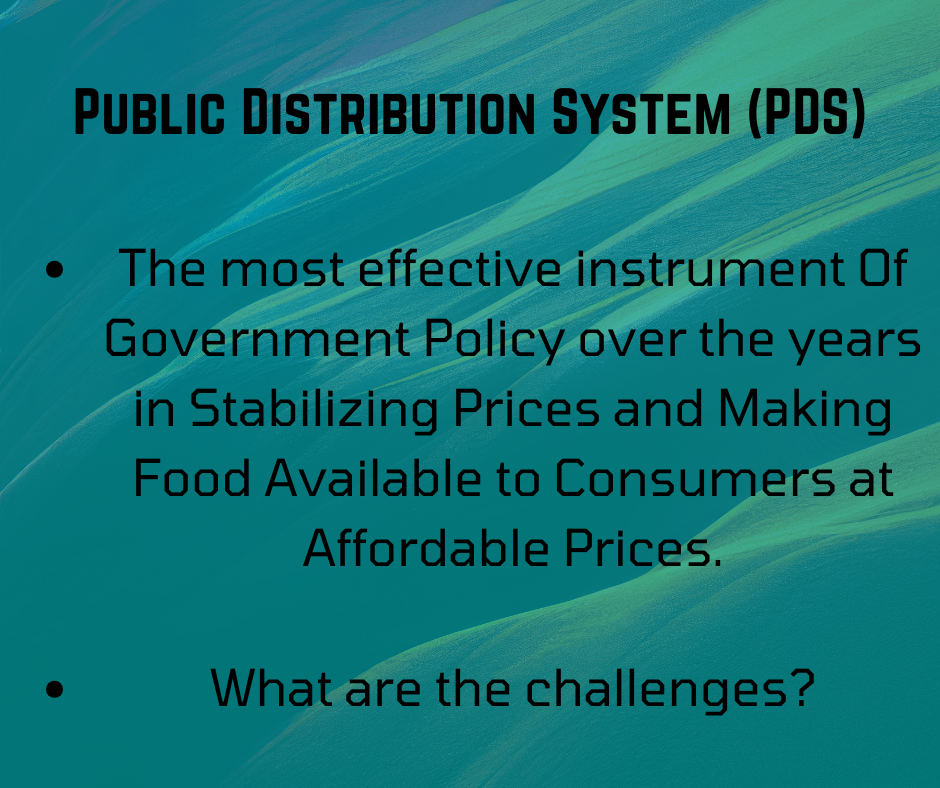2023 GS P3 PYQ Solution, PYQs Solution
Q.15. “The Public Distribution System (PDS) has proved to be the most effective instrument of Government policy over the years in stabilizing prices and making food available to consumers at affordable prices.” Explain the statement.
The statement recognizes the Public Distribution System (PDS) as a key component of India’s food security system and its role in stabilizing food prices and ensuring availability at affordable prices. Here’s an explanation of how PDS has been effective:
Stabilizing Prices: The PDS procures food grains from farmers at assured minimum prices, which helps in stabilizing market prices by absorbing excess supply that could otherwise lead to price crashes. By releasing these stocks during times of price rise, the PDS helps to moderate inflationary pressures on essential commodities.
Affordable Food Access: PDS provides essential food items like wheat, rice, sugar, and kerosene at subsidized rates to the economically vulnerable populations. This ensures that even the poorest segments of society have access to basic food supplies, which is crucial for their sustenance.
Preventing Hoarding and Black Marketing: By maintaining a buffer stock of food grains and ensuring their distribution through Fair Price Shops (FPS), the PDS reduces the chances of hoarding and black marketing, which can otherwise lead to artificial scarcity and price hikes.
Reducing Hunger and Malnutrition: The PDS aims to reduce hunger and malnutrition among economically disadvantaged communities by providing them with access to food grains at affordable prices, thus contributing to the nutritional security of the nation.
Economic Accessibility: The PDS makes food grains available at prices lower than the market rates, which is particularly beneficial during times of drought and high food inflation, protecting poor households from food price increases.
Social Welfare Program: As a critical social welfare program, the PDS continues to evolve with ongoing efforts to modernize and improve the system, aiming to make it more efficient, transparent, and accountable while ensuring that food reaches those in need.
In summary, the PDS has been instrumental in ensuring that the government’s policy objectives of food security and price stability are met, especially for the vulnerable sections of the population. It has also played a significant role in the management of the food economy in the country.
…………………………………………………………………………………………………………………………………………………..
What are some challenges faced by the PDS in India?
The Public Distribution System (PDS) in India, while crucial for ensuring food security, faces several challenges:
1. Leakage and Diversion of Food Grains: There are instances where subsidized grains are illegally sold in the open market, leading to leakage from the intended PDS supply chain.
2. Corruption and Inefficiency: Corruption at various levels of the PDS, including the creation of bogus ration cards and siphoning off food grains, undermines the system’s effectiveness.
3. Quality of Food Grains: Often, the food grains supplied through PDS are of poor quality, which discourages beneficiaries from utilizing the system.
4. Identification of Beneficiaries: Incorrect classification of households as below or above the poverty line can lead to exclusion errors, where the needy are left out, and inclusion errors, where the non-needy get benefits.
5. Inadequate Infrastructure: The lack of proper storage facilities can result in spoilage of food grains before they reach the beneficiaries.
6. Inefficient Functioning of Fair Price Shops (FPS): FPSs sometimes face issues like irregular opening hours, non-display of information, and rude behavior of shop owners.
7. Technological Challenges: While technology is being introduced to improve the PDS, issues such as lack of connectivity and digital literacy among the rural population pose challenges.
Efforts to modernize and improve the PDS are ongoing, with aims to make it more efficient, transparent, and accountable, ensuring that food reaches those in need.
…………………………………………………………………………………………………………………………………………..


